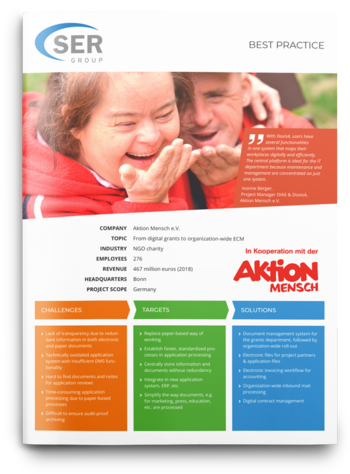SER Blog Innovation & Technology
“No digitalization without clean processes”
More and more companies are digitalizing their business processes – particularly in response to a rising number of remote workers. However, before process transformation takes place, processes must first be streamlined and optimized. What might sound simple frequently poses the biggest challenge for companies, says finance expert Ute Schröder of the management consulting firm C4B-Team GmbH & Co. KG. What makes digitalization so challenging and which prerequisites must companies first meet? Ute Schröder discusses process digitalization in an interview with the SER blog.

For many companies, digitalization is a top priority. Based on your experience working with customers, Ute, why is progress so halting when it comes to digitalization?
In my experience, this is often the result of too few resources and the lack of a digital mindset. Digitalization doesn't always mean huge projects. Sometimes the point is simply to eliminate the last fax. Every activity has to be checked continuously for digitalization and automation potential. This calls for a change in a company’s culture. Additionally, the resources required have to be made available to implement these challenging projects. Many existing processes are also problematic. Studies show that about half of all companies have not yet prepared their data and processes for digitalization. There are weak points in processes in virtually every company. For example, if you get conflicting data from multiple sources, it can pose a setback, and it makes it difficult to automate processes. For digital transformation, you need consistent data and standardized processes. However, so far only a small fraction of companies have achieved this. Most are still in the implementation phase.
What are the prerequisites that have to be satisfied first?
Automation can only succeed when companies understand their processes and interfaces – whether analog or already digital. Nevertheless, it is a major undertaking to analyze all the processes that a company uses, for example, in accounting. Creating accurate and transparent process documentation for all the relevant processes is a true challenge for many companies.
Could you give us an example?
Recently, in one of our benchmarking groups, we learned about an international retail company that, as a part of their plan to digitalize processes in finance, they first audited the invoice verification process. The three-step process of invoice receipt, verification and release revealed a total of 174,000 variants in the entire company with approximately 3 million invoices received. With 174,000 variants – how do you intend to automate that? But this is the first step and the correct step – and it is critical – because work processes have to first be identified, structured and made comprehensible. This is the only way to optimize them. And accounting standards also legally require companies to create and regularly update process descriptions.

Aktion Mensch e.V: Faster Funding for Social Projects
How non-profit organization Aktion Mensch uses the Doxis ECM platform to digitalize its processes and maintain a consistent basis of information on project funding
Read nowBased on your experience, where are the pitfalls – and how can companies avoid them?
There are always pitfalls when it comes to a company’s in-house, custom solutions and processes. If you don’t want to get tripped up, you have to standardize your processes. Only at this point can new technologies be used. One of the finance experts who works very closely with C4B is Denis Glowicki, CFO at Wicke. He once described the interface dilemma very accurately. For companies with more than ten employees, it is difficult to understand all the work steps involved; everyone becomes an expert in his or her sub-area, with a limited view to the right and left. Employees lose oversight of the upstream and downstream processes for their own activities. These activities are simply carried out and are often no longer questioned in terms of their value. This situation makes it impossible to improve or optimize a process. Process documentation is also about identifying these interfaces and then optimizing them and sharing the knowledge. In other words, asking which work step comes before and after me? Incidentally, this has also been one of the lessons learned by many companies during the pandemic: Processes have to be transparent and comprehensible for all employees. Only then does everything run smoothly when working remotely.
What is the best way to document a process?
It is generally hard to manage a task of this magnitude on your own. There are many consultants who can support companies with process documentation. However, my business partner Dennis Cichowski and I take a different approach. Working together with four additional finance professionals, we have developed a tool for process documentation – C4B Manuals. In our solution, predefined processes and pre-modeled flowcharts help to map the company's individual processes in virtually no time at all. So companies do not need to hire external consultants or expensive consulting services. For this project, we worked with hsp Software GmbH.
How exactly do C4B Manuals work?
The individual steps are organized as found in most companies. The processes are already on file and the flowcharts are pre-modeled. After installing the software, you can work directly with the existing process description and adjust each of the individual steps. Our best practice process steps also provide many digitalization and automation tips. It is, so to speak, a living document. As soon as something is adjusted in the steps, the flowchart on the right is updated so that it matches the live demo. Our solution is also collaborative, because multiple people can work in the tool, allocate tasks, store documents, and assign risks and internal controls. With its predefined processes, our tool is one-of-a-kind on the market and basically provides a blueprint for all the processes in finance.

Ute Schröder, management and controlling expert, is the Managing Director of C4B-Team GmbH & Co. KG [https://c4b-team.de/]. More than 10 years ago, she founded the professional work group for finance experts C4B Benchmarking Circle, a group which also worked for many years at Jungheinrich, where she was Head of International Controlling.
The latest digitization trends, laws and guidelines, and helpful tips straight to your inbox: Subscribe to our newsletter.
How can we help you?
+49 (0) 30 498582-0Your message has reached us!
We appreciate your interest and will get back to you shortly.




